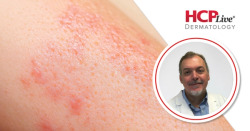
OR WAIT null SECS
SEL-212 Shows Significant Response Rates, sUA Reductions in Patients with Gout
Investigators believe targeted immunomodulation with SEL-212 may have the potential to introduce a new uricase-based therapy for patients with gout refractory to conventional treatment.
In patients with gout, once-monthly treatment with SEL-212 resulted in significant response rates and reductions in serum uric acid (sUA) when compared with placebo, according to the study “Safety & Efficacy of SEL-212 in Patients with Gout Refractory to Conventional Treatment: Primary Outcomes from Two Randomized, Double Blind, Placebo-Controlled, Multicenter Phase 3 Studies,” presented at the American College of Rheumatology’s 2023 Convergence in San Diego, California.1 Additionally, the safety profile of SEL-212 was comparable to uricase therapies. Investigators believe targeted immunomodulation with the drug may have the potential to introduce a new uricase-based therapy for patients with gout refractory to conventional treatment.
“In patients with refractory gout, the inability to maintain sUA levels <6 mg/dL leads to severe clinical manifestations for which uricase-based therapies can be highly effective, though also immunogenic,” wrote lead investigator Herbert Baraf, MD, FACP, MACR, associated with the Center for Rheumatology and Bone Research, George Washington University, Rheumatology, and colleagues.
In the DISSOLVE 1 and DISSOLVE 2 trials, patients with refractory gout received SEL-212, a once-monthly, novel 2-component, uricase-based infusion therapy. The treatment regimen consists of an infusion of tolerogenic nanoparticles containing rapamycin, followed by pegadricase. The trails assessed the safety and efficacy of the treatment in patients with refractory gout.
The placebo-controlled, double-blind trials randomized patients 1:1:1 to receive SEL-110 (.15 mg/kg [high-dose] or .1 mg/kg [low-dose]) prior to SEL-037 (0.2 mg/kg) infusion, or placebo, administered intravenously every 28 days for 6 treatments. In DISSOLVE 1, patients continued in a 6-month blinded extension phase, and the primary endpoint was the percentage of patients who achieved and maintained sUA <6 mg/dL for ≥80% of the treatment period. Tolerability and safety were determined using the monitoring of adverse events.
Eligible patients had ≥3 gout flares within 18 months prior to screening or ≥1 tophus or a current diagnosis of gouty arthritis, had failed to normalize sUA and control symptoms with a xanthine oxidase inhibitor, and did not have previous exposure to a pegylated uricase-based therapy. Nonresponders were subjects who discontinued the study due to adverse events and COVID-19.
In the DISSOLVE 1 study, 38 patients were placed in the high-dose group, 37 patients were placed in the low-dose group, and 37 were given the placebo. In the DISSOLVE 2 group, 49 patients received the high-dose SEL-212, 51 received the low-dose treatment, and 53 received placebo.
A total of 112 subjects were enrolled in DISSOLVE 1 (96% male, 66% ≥50 years) and 153 were included in DISSOLVE 2 (97% male, 72% ≥ 50 years). Patients treated with SEL-212 had significantly different response rates when compared with placebo, with 56% and 46% of patients in the high-dose group responding in DISSOLVE 1 and DISSOLVE 2, respectively, as well as 48% and 40% of patients responding in the low-dose group for DISSOLVE 1 and DISSOLVE 2, respectively. Safety was favorable in SLE-212 treatment groups, with 3.4% of patients in the high-dose group and 4.5% in the low-dose group experiencing adverse events. Gout flare rates were comparable between patients receiving the treatment and placebo. A total of 6 patients (3.4%) reported treatment-related serious adverse events, of which 4 had anaphylaxis and 2 had gout flares.
References
- Baraf H, Kivitz A, Rhodes S, Leung S, et al. Safety & Efficacy of SEL-212 in Patients with Gout Refractory to Conventional Treatment: Primary Outcomes from Two Randomized, Double Blind, Placebo-Controlled, Multicenter Phase 3 Studies. Presented at: American College of Rheumatology Convergence 2023. San Diego, CA. November 10-15, 2023.
Related Content:


